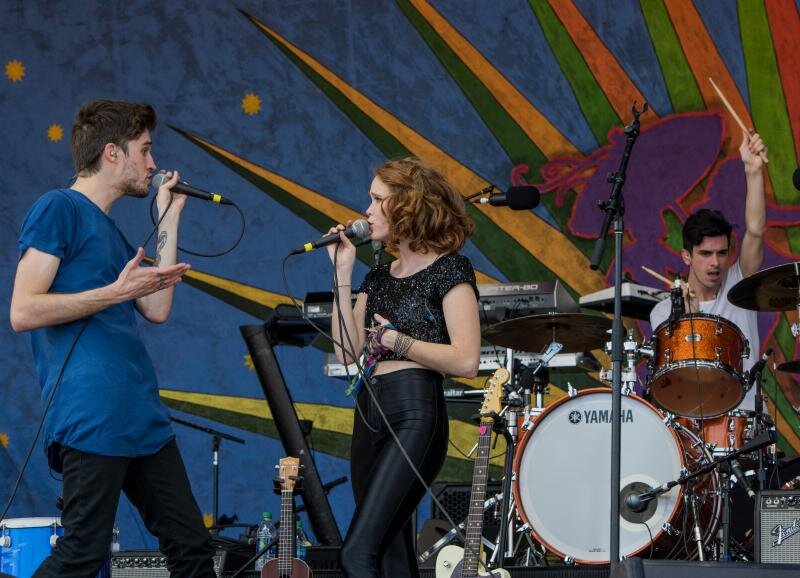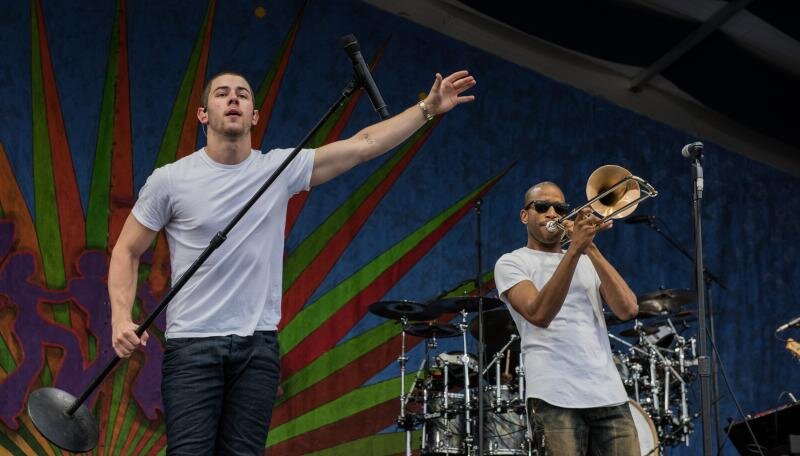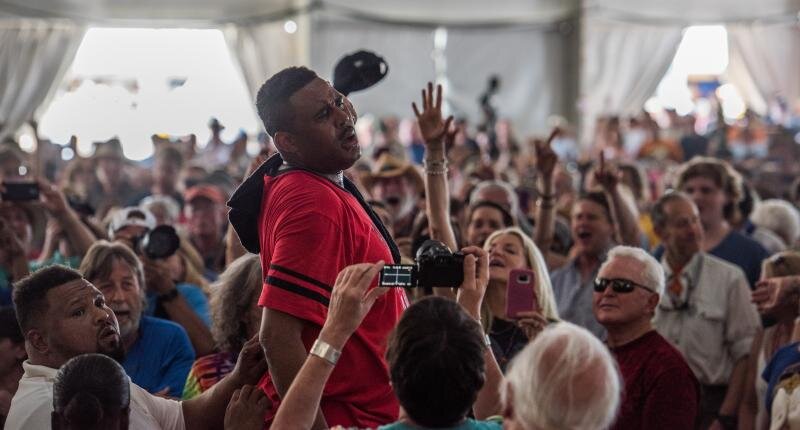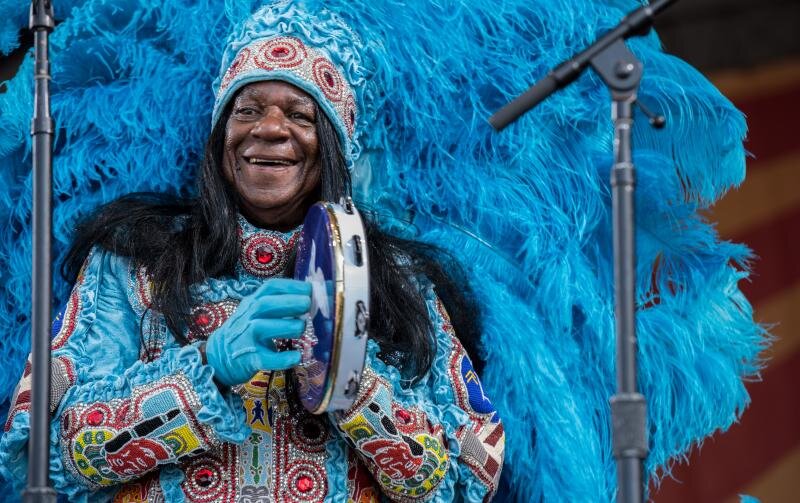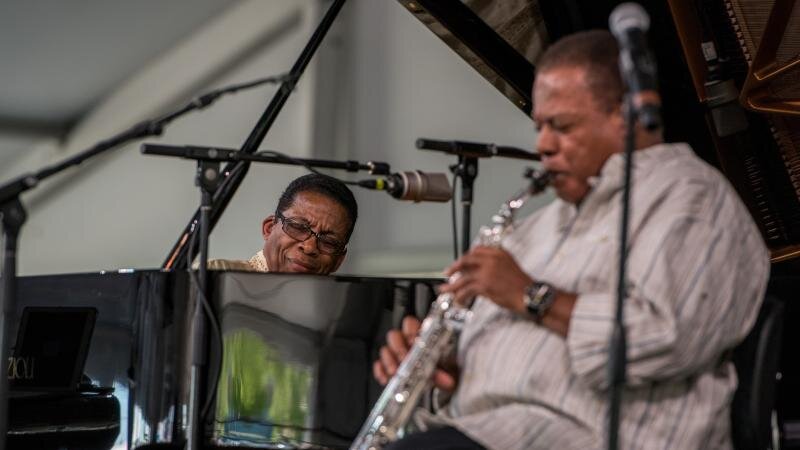Jazz Fest: Context Works Against Red Hot Chili Peppers
The proximity of other funky bands mutes one of the Los Angeles band's claims to fame.
Everything is relative. At a Lollapalooza or a rock festival, Red Hot Chili Peppers are funky. At Jazz Fest, they’re a rock band. They love funk, and Flea can be a funky bassist, but their rock is stronger than their funk, and it shows in a place where funkier bands are all around. Sunday, they surprised almost no one when they brought out The Meters with Ivan Neville subbing for Art to join them on the set-ending “Give It Away.” The two bands jammed together at Voodoo in 2006, and Meters’ guitarist Leo Nocentelli played the Acura Stage a few hours before the Chili Peppers.
The Chili Peppers and J. Cole at Congo Square tested the effectiveness of the new bleachers more than Pearl Jam and Maxwell did on Saturday. Both acts drew larger crowds than their Saturday counterparts, and with mixed results. The bleachers were well-used, and they kept the track from filling with ad hoc encampments. Instead, on Sunday columns of people stretched across the track in the spots that afforded some view of the stage. It was easy to walk behind a stand of bleachers, but getting through the column required a little navigation, and the situation was the same at J. Cole near the front. The situation wasn’t perfect yet, but it was much better than the exhausting slog through a tenth of a mile of single-file foot traffic.
J. Cole had the crowd with him all the way back to the memorial garden at the back of the Congo Square Stage, even though the fans back there got soundbleed from the Red Hot Chili Peppers on Acura and Pocket Aces Brass Band on the Jazz and Heritage Stage. Cole’s personal charisma and his persona—the reasonable, small town guy trying to stay true to himself in a crazy world—is a winning one. True, few of us have to deal with the price of fame that he scrutinized on 2014 Forest Hills Drive and throughout his career, but the broad strokes spoke to people. Just as the lyrics in “Crooked Smile” move from the pressure to have straight teeth to be a star to the pressure women are under to conform to conventional notions of beauty, the overflow crowd for Cole took his songs at the levels that resonated for them and clearly felt them.
Cole’s allergy to the trappings of success lead him to lay off the gold chains and showy kicks, but on Sunday he did depart from his usual stage attire—a T-shirt—to perform in a Minnesota Vikings jersey with the Prince glyph instead of a number, and the name “Prince” across the back. Still, you could see why he’s linked in conversations to Kendrick Lamar. Both have hit on a variation of conscious hip-hop that’s more about picking your own path thoughtfully than defining yourself against the mainstream.
For more on J. Cole’s set, see my review at Nola.com.
If we rank shows by the number of standing ovations, Rhiannon Giddens’ set in the Blues Tent Sunday might have been one of the best ever at Jazz Fest. She earned four that I saw, and there’s no reason that the crowd would break the string or that she’d go south on the set. Giddens approached American folk and country music not as artifacts from days of yore but as stories to tell the best she can. That meant simultaneously embracing the musicality of the songs and the dignity of the people in them. The woman is more resolute in Giddens’ version of “Don’t Let it Trouble Your Mind” than we hear in Dolly Parton’s, where the focus is on her heartbreaking sacrifice. You know the woman in “Last Kind Words,” whereas part of the appeal of Geechie Wiley’s recording is her enigmatic presence.
In concept and as music, everything Giddens did was impressive, but the number of standing ovations made me wonder what they were about. What was it in Giddens’ performance that spoke to them so clearly that the audience responded so swiftly and powerfully. Obviously, it might be the observations I just made, but I wondered as well if part of the appeal was the way Giddens made the songs into art—not folk art, but sophisticated, consciously crafted art. If she presented folk music to people in the way they’ve always wanted it—made by erudite, deliberate people with a literary sensibility. Are those the only two possibilities—folk music as naive art or folk music as gallery art? There was nothing in the moment at Giddens’ show that should have been different, but watching the artful treatment of folk music and the reception of it illustrated what is perhaps a complicated class dynamic, perhaps one worth thinking about.
Maybe people would have responded to Leyla McCalla’s set on the Lagniappe Stage much the same way if she didn’t sing in Creole French. McCalla and Giddens clearly share a friendship from the days in the Carolina Chocolate Drops, and they share a sensibility. She too brings a literary and musical consciousness to American and Haitian folk songs that the people who made them didn’t possess, and she understands folk music well enough that she can write in that semi-naive lyrical voice. The Haitian troubadour songs were not as simple as they sound though, with a fairly simple image—a girl being asked by her mom why she doesn’t fish in the river—standing for a conversation on youth and sexuality in Haiti. As small and simple as McCalla’s songs sounded, there were big thoughts inside them.
For more on the day including additional notes on Giddens and McCalla, see my review at USA Today.
Elsewhere at Jazz Fest:
- Sometimes you get the right audience. Sunday, Nick Jonas was the headliner on the Gentilly Stage, and the scheduling that day skewed toward youth appeal. Royal Teeth have generally done well at Jazz Fest, but Sunday’s crowd was particularly crazy for them. It was their strongest Jazz Fest set yet and included a number of promising new songs, but people went off for “Wild” the way the song’s energy and sing-along chorus suggest should happen. A woman near the soundboard jumped and waved her hands in the air for the whole of the song, and a young woman near me danced and sang it to her friend. Throughout the Gentilly Stage crowd, people danced in a way that they rarely do at Jazz Fest.
- Can anybody remember a Jazz Fest with so many schedule issues? On Friday, I walked by the Jazz Tent and instead of finding Christian Scott five minutes into his set, people were still getting ready. I missed the end of Rhiannon Giddens’ set because she was a half-hour late, which was the result of the band before her going long. Or so I’m told. Alpha Blondy was 35 minutes late, but he did make his 12:15 appearance in the Allison Miner Music Heritage Stage. Van Morrison started early, and Janelle Monae quit 20 minutes early. That was understandable, but Red Hot Chili Peppers ended 15 minutes early. Nick Jonas packed it up 10 minutes early. Does nobody have watch or mechanical device that keeps track of time anymore?
- Prince tribute scorecard: Better Than Ezra ended with “Raspberry Beret,” and Nick Jonas performed a mournful “I Would Die 4 U” and “Purple Rain.”
Click on the photos to see them in a viewer.
